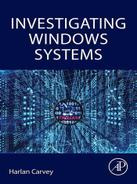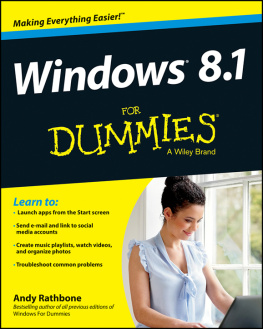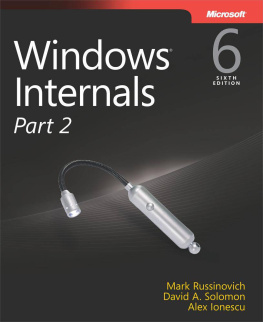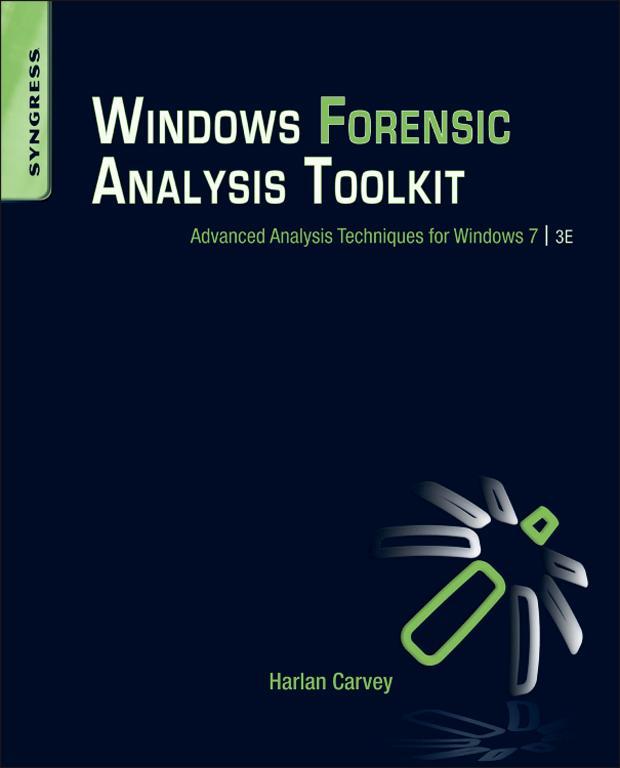Windows Forensic Analysis Toolkit
Harlan Carvey
Technical Editor
Jennifer Kolde

Windows Forensic Analysis Toolkit
Acquiring Editor: Chris Katsaropoulos
Development Editor: Heather Scherer
Project Manager: Jessica Vaughan
Designer: Alisa Andreola
Syngress is an imprint of Elsevier
225 Wyman Street, Waltham, MA 02451, USA
Copyright 2012 Elsevier Inc. All rights reserved
No part of this publication may be reproduced or transmitted in any form or by any means, electronic or mechanical, including photocopying, recording, or any information storage and retrieval system, without permission in writing from the Publisher. Details on how to seek permission, further information about the Publishers permissions policies, and our arrangements with organizations such as the Copyright Clearance Center and the Copyright Licensing Agency, can be found at our website: www.elsevier.com/permissions.
This book and the individual contributions contained in it are protected under copyright by the Publisher (other than as may be noted herein).
Notices
Knowledge and best practice in this field are constantly changing. As new research and experience broaden our understanding, changes in research methods or professional practices may become necessary. Practitioners and researchers must always rely on their own experience and knowledge in evaluating and using any information or methods described herein. In using such information or methods they should be mindful of their own safety and the safety of others, including parties for whom they have a professional responsibility.
To the fullest extent of the law, neither the Publisher nor the authors, contributors, or editors assume any liability for any injury and/or damage to persons or property as a matter of products liability, negligence or otherwise, or from any use or operation of any methods, products, instructions, or ideas contained in the material herein.
Library of Congress Cataloging-in-Publication Data
Carvey, Harlan A.
Windows forensic analysis toolkit advanced analysis techniques for Windows 7 / by Harlan Carvey.
p. cm.
Includes bibliographical references.
ISBN 978-1-59749-727-5
1. Computer crimesInvestigationUnited StatesMethodology. 2. Microsoft Windows (Computer file)Security measures. 3. Computer networksSecurity measures. 4. InternetSecurity measures. 5. Computer security. I. Title.
HV8079.C65C3726 2012
363.25968dc23
2011043150
British Library Cataloguing-in-Publication Data
A catalogue record for this book is available from the British Library
ISBN: 978-1-59749-727-5
Printed in the United States of America
11 12 13 14 15 10 9 8 7 6 5 4 3 2 1

For information on all Syngress publications, visit our website at www.syngress.com.
To Terri and Kylieyou are my light and my foundation.
Preface
I am not an expert. I have never claimed to be an expert at anything (at least not seriously done so), least of all an expert in digital forensic analysis of Windows systems. I am simply someone who has found an interest in my chosen field of employment, and a passion to dig deeper. I enjoy delving into and extending the investigative process, as well as exploring new ways to approach problems in the field of digital forensic analysis. It was more than 13 years ago that I decided to focus on Windows systems specifically, in large part because no one else on the team I worked with at the time did so. We had folks who focused on routers and firewalls, as well as those who focused on Linux; however, almost no effort, beyond enabling configuration settings in the vulnerability scanner we used, was put toward really understanding Windows systems. As I moved from vulnerability assessments into incident response and digital forensic analysis, understanding what was happening under the hood on Windows systems, understanding what actions could create or modify certain artifacts, became a paramount interest. I am not an expert.
When I sat down to write this book, I wanted to take a different approach from the second edition; that is, rather than starting with the manuscript from the previous edition and adding new material, I wanted to start over completely and write an entirely new book, creating a companion book to the second edition. As I was writing the second edition, Windows 7 was gaining greater prominence in the marketplace, and there has been considerably more effort dedicated toward and developments as a result of research into Windows 7 artifacts. Even now, as I write this book (summer 2011), Windows 8 is beginning to poke its head over the horizon, and it likely wont be too awfully long before we begin to see Windows 8 systems. As such, theres a good deal more to write about and address, so I wanted to write a book that, rather than focusing on Windows XP and looking ahead now and again to Windows 7, instead focused on Windows 7 as an analysis platform and target, and refer back to previous versions of Windows when it made sense to do so.
Therefore, regardless of the title, this book is not intended to replace the second edition, but instead to be a companion edition to be used alongside the second edition. Let me say that againif you have the second edition of Windows Forensic Analysis, you will not want to get rid of it and replace it with this book. Instead, youll want to have both of them (as well as Windows Registry Forensics and Digital Forensics with Open-Source Tools) on your bookshelf or Kindle (or whichever ebook platform youre using). In fact, if you have just purchased this edition, you will want to also purchase a copy of the second edition, as well.
I will say upfront that there are some things not covered in this book. When writing this book, I did not want to reiterate some of the information available in other media, including previous editions of Windows Forensic Analysis. As such, while mentioning how physical memory can be collected from a Windows system, this book does not go into detail with respect to memory analysis; truthfully, this is a topic best covered in a book of its own. In this book, we also discuss malware detection within an acquired image, but we do not discuss malware analysis, as this topic has been addressed extremely well in its own book.
Intended Audience
This book is intended for anyone with an interest in developing a greater understanding of digital forensic analysis, specifically of Windows 7 systems. This includes digital forensic analysts, incident responders, students, law enforcement officers, and researchers, or just anyone whos interested in digital forensic analysis of Windows 7 systems. Even system administrators and hobbyists will get something useful from this book. Ive tried to point out how the information in this book can be used, by both forensic analysts and incident responders alike.
In reading this book, youll notice that there are several tools described throughout that were written in the Perl scripting language. Dont worry, you dont need to be a Perl expert (after all, neither am I) to use these scripts; not only are the scripts very simple to use, but in most cases, they are accompanied by Windows executables, compiled using Perl2.exe (found at









